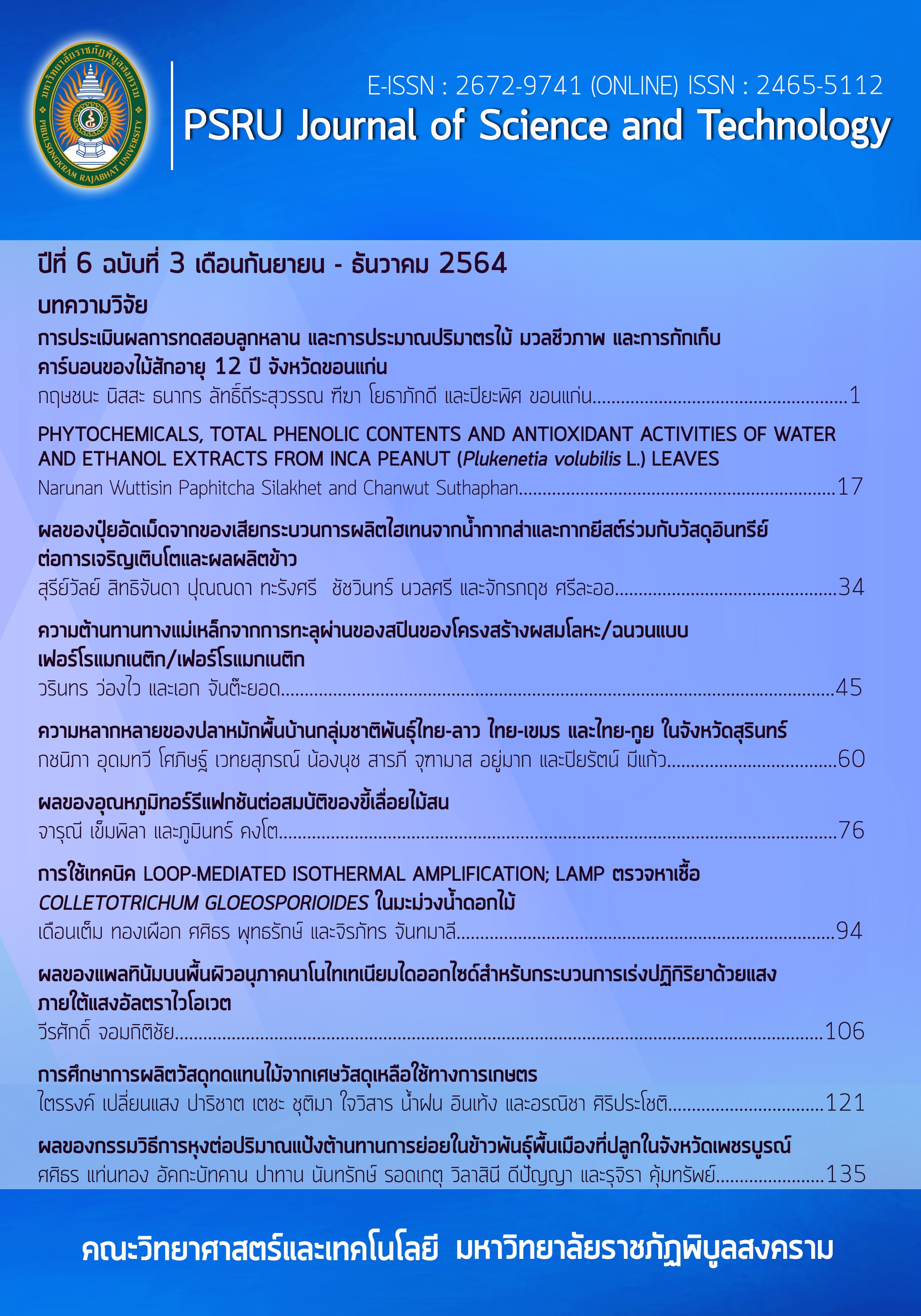EFFECT OF COOKING TREATMENTS ON RESISTANT STARCH CONTENT IN LOCAL RICE VARIETY GROWN IN PHETCHABUN PROVINCE
Keywords:
Local rice varieties, Phetchabun, Cooking treatments, Resistant starchAbstract
Increasing the amount of resistant starch in various rice varieties was the purpose of this research. Rice varieties used in the experiment were Jasmine rice, RD 43, Luem Pua, Khao Hmong, Paya Luem Kaeng and Rong Thanon. First, rices will be cooked in five methods and then analyzed for the amount of resistant starch. It was found that cooked rice had 7.15 - 16.35% of resistant starch depend on polishing and varieties. Brown rice had higher resistant starch than polished rice. Methods of increasing the amount of resistant starch in rice varieties were found that 1) Resistant starch in jasmine rice were 6.52-7.56% while raw rice had resistant starch similar to cooked rice 2) RD 43 had 6.57-8.81% of resistant starch, while the best method for increasing resistant starch in this rice to 18.10% was ultrasonic, autoclaving and chilling, respectively 3) Luem Pua, cooked brown rice by microwave and chilling was increased resistant starch to 26.05% 4) White Hmong had 7.61-11.07% of resistant starch and cooking by rice cooker was increased resistant starch to 37.69% 5) Paya Luem Kaeng had 9.03-9.72% of resistant starch, while cooking by rice cooker and chilling for 60 hours was the best method for increasing resistant starch to 12.89% 6) Resistant starch in Rong Thanon was 8.86-11.10% and the best method was cooking by rice cooker. Therefore, this information can be used in choosing rice consumption. The methods possibly increase the highest amount of resistant starch and make the rice become more health functional food.
References
จิรนาถ บุญคง. (2557). การใช้แป้งกล้วยหอมทองดิบที่มีสมบัติต้านทานการย่อยสลายด้วยเอนไซม์ในผลิตภัณฑ์พาสต้า. วารสารเทคโนโลยีการอาหาร มหาวิทยาลัยสยาม, 10(1), 19–29.
จิรนาถ บุญคง. (2558). Resistant starch แป้งที่มีบทบาทต่อสุขภาพ. วารสารเทคโนโลยีการอาหาร มหาวิทยาลัยสยาม, 6(1), 1-7.
ฉวีวรรณ วุฒิญาโน. (2543). พันธุ์ข้าวเมืองไทย, เอกสารวิชาการศูนย์ปฏิบัติการและเก็บเมล็ดเชื้อพันธุ์ข้าวแห่งชาติ ศูนย์วิจัยข้าวปทุมธานี สถาบันวิจัยข้าว กรมวิชาการเกษตร.
ดำเนิน กาละดี, และศันสนีย์ จำจด. (2543). พันธุศาสตร์การปรับปรุงพันธุ์และโภชศาสตร์เกษตรของข้าวเหนียวดำ (รายงานวิจัยฉบับสมบูรณ์). สถาบันวิจัยและพัฒนา วิทยาศาสตร์และเทคโนโลยี มหาวิทยาลัยเชียงใหม่.
ธนาภร รติธรรมธร. (2559). ผลของการให้ความร้อนและการทำให้เย็นที่มีต่อการเปลี่ยนแปลงโครงสร้างและการย่อยของแป้ง. วารสารวิทยาศาสตร์บูรพา, 21(2), 248–259.
ธนาภร รติธรรมธร. (2560). แป้งต้านทานการย่อย. วารสารวิทยาศาสตร์บูรพา, 22(1), 166–176.
ประพาส วีระแพทย์. (2555). ความรู้เบื้องต้นเรื่องข้าว. กรุงเทพฯ: สำนักวิจัยและพัฒนาข้าว กรมการข้าว.
มาตรฐานข้าวหอมมะลิไทย กรมการข้าว. (2544). คุณภาพและการตรวจสอบข้าวหอมมะลิไทย. กรุงเทพฯ:กรมวิชาการเกษตรและสหกรณ์ กระทรวงเกษตรและสหกรณ์.
มาโนชญ์ สุธีรวัฒนานนท์. (2558). การเพิ่มปริมาณแป้งต้านทานการย่อยในผลิตภัณฑ์พาสต้าข้าวเจ้า (รายงานผลการวิจัย). สาขาวิชาเทคโนโลยีอาหาร สำนักวิชาเทคโนโลยีการเกษตร: มหาวิทยาลัยเทคโนโลยีสุรนารี.
เชาวนีพร ชีพประสพ, หาสันต์ สาเหล็ม, และฤทัยทิพย์ อโนมุณี. (2560). องค์ประกอบทางเคมีและปริมาณอะไมโลสในข้าวพันธุ์พื้นฐานจังหวัดพัทลุง. วารสารวิทยาศาสตร์และเทคโนโลยี มทร.ธัญบุรี, 7(2), 84 – 97.
ศุภนาถ เห็นสว่าง. (2560). ข้าว..ความสำคัญ คุณค่าทางอาหาร และการปนเปื้อน. วารสารสิ่งแวดล้อม, 21(1), 15–18.
อรณี แก้วกก. (2558). การวิเคราะห์หาคุณสมบัติทางเคมีบางประการในข้าวพื้นเมืองจังหวัดเพชรบูรณ์ (รายงานผลการวิจัย). เพชรบูรณ์: มหาวิทยาลัยราชภัฏเพชรบูรณ์.
Alexander, R.J. (1995). Resistant starch-new ingredient for the food industry. Cereal Foods World, 40(6), 455-458.
Eerlingen, R.C., Crombez, M., & Delcour, J.A. (1993). Enzyme-Resistant Starch. I. Quantitative and Qualitative Influence of Incubation Time and Temperature of Autoclaved Starch on Resistant Starch Formation. Cereal Chemistry, 70(3), 339-344.
Englyst, H., & Cummings, J. (1987). Dietary fiber and resistant starch. The American Journal of Clinical Nutrition, 46, 873-874.
Frankel, O.H., Brownand, A.D.H.. & Burdon,J.J. (1995). The Conversation of Plant Biodiversity, Cambridge: Cambridge University Press, 299.
Ferguson, L.R., Tasman-Jones, C., Englyst, H., & Harris, P.J. (2000). Comparative effects of three resistant starch preparations on transit time and short-chain fatty acid production in rats. Nutrition and Cancer, 36, 230-237.
Hung, P.V., Vien, N.L., & Phi, N.T.L. (2016) Resistant starch improvement of rice starches under a combination of acid and heat-moisture treatments. Food Chemistry, 191, 67-73.
Raben, A., Tagliabue. A., Christensen, N.J., Madsn, J., Holst, J.J. & Astrup, A. (1994). Resistant starch: The effect on postprandial glycemia, hormonal response and satiety. The American Journal of Clinical Nutrition, 60, 544 -551.
Sajilata, M.G., Singhal, R.S., & Kullarni, P.R. (2006). Resistant starch: A review. Comprehensive Reviews in Food Science and Food Safety, 5(1), 1-17.
Tripathy, S., Gurung, P., & Sharma, S.D. (2005). Intellectual property contribution with regard to rice genetic resources by tribes of South Orissa, India, Plant Genetic Resources Newsletter, 141, 61-64.
Zeng, S., Wu, X., Lin, S., Zeng, H., Lu, X., Zhang, Y., &, Zheng, B., (2015). Structural characteristics and physicochemical properties of lotus seed resistant starch prepared by different methods. Food Chemistry, 186, 213-222.
Downloads
Published
How to Cite
Issue
Section
License
กองบรรณาธิการขอสงวนสิทธิ์ในการปรับปรุงแก้ไขตัวอักษรและคำสะกดต่างๆ ที่ไม่ถูกต้อง และต้นฉบับที่ได้รับการตีพิมพ์ในวารสาร PSRU Journal of Science and Technology ถือเป็นกรรมสิทธิ์ของคณะวิทยาศาสตร์และเทคโนโลยี มหาวิทยาลัยราชภัฏพิบูลสงคราม และ
ผลการพิจารณาคัดเลือกบทความตีพิมพ์ในวารสารให้ถือมติของกองบรรณาธิการเป็นที่สิ้นสุด







